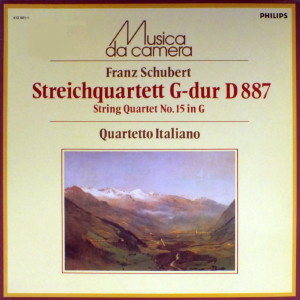 |
|
Philips
- 1 LP - 412 401-1
|
|
QUARTETTO ITALIANO
- Paolo Borciani, Elisa Pegreffi, violino
- Piero Farulli,
viola
- Franco Rossi, violoncello |
|
|
|
|
|
Luogo e data
di registrazione |
|
Musica
Thť‚tre
Salle de Musique, La
Chaux-de-Fonds (Svizzera)
-
17-23 luglio 1977 |
|
|
Registrazione: live
/ studio |
|
studio |
|
|
Producer / Engineer |
|
Vittorio Negri |
Willem
van Leewen
|
|
|
Edizione LP |
|
Philips | 412
401-1
| 1 LP |
|
|
Prima Edizione CD |
|
Vedi link alla prima
edizione in long playing.
|
|
|
Note |
|
La
collana
"Musica da
Camera" della
Philips
riedita negli
anni
'80
alcune
registrazioni
del Quartetto
Italiano. |
|
|
|
|
On
March 31,
1824, Schubert
wrote to his
friend Leopold
Kupelwieser "I
have not
written many
new songs, but
I have tried
my hand at
several
instrumental
works, for
I have
composed two
string
quartets, and
an octet, and
I want to
write another
quartet, in
fact I estend
to pave
my way
howards a
grand symphony
in this way.
"The two
quartet
referred to
here as being
already
written are
the A minor,
D. 804 and the
D minor, D.
810; the
third, the G
major, D. 887
(Schubert's
last quartet
was not
written until
two years
later). It
seems likely
that Schubert
intended to
publish the
first two
quartets as
Op. 29 Nos. 1
and 2, but in
fact only the
A minor
appeared in
print during
his lifetime;
the D minor
was published
in 1832, four
years after
his death, the
G major not
until 1851.
Although we
may assume
that watches
(mental, if
not physical)
had been in
existence for
some time
previously,
the G major
Quartet was
actually
committed to
papae within a
mere 11 days,
between June
20 and 30,
1826. A
private
performance
took place
soon after
this, and the
first movement
appears to
have been
played by the
Schuppanzigh
Quartet in
March 1828 at
a concert
arranged by
Schubert
himself, but
there is no
record of the
work's being
performed in
its entirely
and in public
earlier 1850.
The
first movement
is perhaps the
locus classicus
of the
alternation of
major and
minor
tonalities
that is such a
characteristic
Schubertian
fingerprint.
It opens with
a soft G major
chord that
culminates,
after a
crescendo, in
a fortissimo
in G minor,
the process is
repeated six
bars further
on in D major
and D minor.
In the
recapitulation
the procedure
is reversed (G
minor to G
major, D minor
to D major,
while the
closing bars
of the
movement
present the
two opposing
principles in
close
justaposition,
G major only
just emerging
as the victor.
The
movement is
also
remarkable for
its bold use
of tremolo.
The true fast
subject is a
short motif in
dotted rhythm
played in
dialogue
between the
first violin
and cello (and
derived from
the initial
chord's
answering
phrase), which
together with
the substance
of the very
opening
gesture,
provides the
material for
the
impassioned
development
section; the
second subject
is a
syncopated
tune on which
Schubert
duells at
understandable
lenght.
The
Andante
(in E minor)
is a rondo, in
which the
refrain takes
the shape of a
gentle,
elegiac tune
on the cello.
The movement's
quiet
beginning
could hardly
be farther
from
suggesting the
dramatic,
impassioned
nature of the
two episodes
(in G minor
and d minor),
where the
tremoles
figuration of
the first
movement
reappears and
where
Schubert's use
of contrasting
keys has an
andacity that
almost
anticipates
Bartůk.
The
remaining two
movements are
more
convenctional
to idiom. The
first is a B
minor scherzo
of tremendous
rhythmic
impetus
(notice the
repeated notes
in all parts,
which again
remind us of
the tremolo
patterns in
the first two
movements),
enclosing a G
major trio of
Lšndler
like charm.
The second is
an extended
and
rejourceful
sonata rondo,
in almost
uninterrupted
6/8 quaver
rhythm and
with the same
major minor
ambivalence we
noticed in the
opening Allegro.
The second
theme, which
initiates the
first episode,
has a
Rossinian
nonchalance,
and the third,
which is the
basic of the
second
(development)
episode, sems
to take its
tue from the
scherzo of
Beethoven's
Fifth
Symphony. One
cannot help
feeling that
here Schubert
provided, with
complete
success, the
release of
tension after
three preceding
movements that
Mozart
attempted to
achieve in the
G major finale
of his
string Quintet
in G minor.
Robin
Golding
|
| Illustration:
Anton Romako (1832-1889) "Das
Gasteiner Tal" (÷sterreichische
Galerie, Wien) |
|